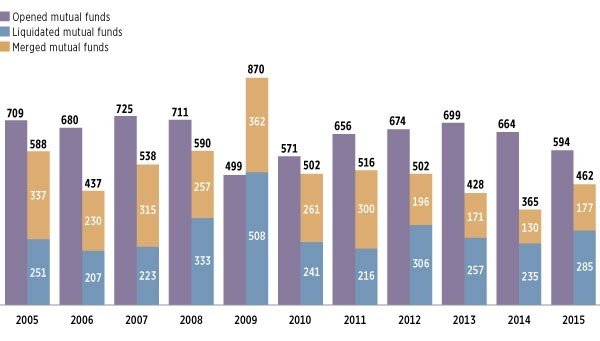ICI Viewpoints
Yes, Funds Come and Go—Without Government Help
For several years now, ICI has pushed back against those advocating for bank-like regulations on the asset management industry, pointing out the numerous reasons why regulated funds or their managers are not sources of risk to the overall financial system.
One of the main arguments made by the Institute is the fact that mutual funds simply do not “fail” in the way that banks do. Hundreds of stock and bond mutual funds and dozens of fund managers exit the business each year—and none of them require a “bailout,” including government intervention or taxpayer assistance.
A report from Standard & Poor’s released this week bolsters this point, saying that 23 percent of stock mutual funds, and 17 percent of fixed-income funds, were merged or liquidated during the past five years.
As usual, none of these mergers or liquidations caused a systemic problem, and none required government financial assistance.
Funds Aren’t Like Banks—And Shouldn’t Be Regulated as Such
ICI has examined this phenomenon in depth, explaining why living wills and “orderly resolution” mechanisms—tools that can help regulators “resolve” a failing institution in a way that minimizes risks to the broader financial system—may be appropriate for banks, but don’t apply to mutual funds. This is because, unlike banks, stock and bond funds don’t guarantee investors a rate of return, or even a return of principal. Instead, all positive or negative investment results belong to the fund’s investors on a pro rata basis. Investors benefit if a fund’s value rises, and absorb the losses if a fund’s value falls.
There are three main reasons why living wills and an orderly resolution mechanism are unnecessary for mutual funds and the firms that sponsor or manage them, according to an ICI paper on the issue:
- Funds and fund managers exit the business routinely, in an orderly way, even during periods of market stress.
- The structure and regulation of funds, along with the competitive dynamics of the fund industry, help facilitate these orderly exits.
- Funds and managers have exit strategies that can be executed within the existing regulatory framework.
Though that paper was published in 2014 and contains data through 2013, the more current chart below shows that funds continue to enter and leave the industry, reflecting the robust competition in the market for funds. Depending on demand and economic conditions, fund sponsors constantly create new funds to meet investor demand, and merge or liquidate funds that don’t attract enough investors and thus don’t achieve the economies of scale needed to run them efficiently.
Number of Mutual Funds Leaving and Entering the Industry
2005–2015

Note: Data include mutual funds that do not report statistical information to the Investment Company Institute and mutual funds that invest primarily in other mutual funds.
Since passage of the Investment Company Act of 1940, the fund industry has grown tremendously and successfully helped many millions of Americans realize their long-term financial goals—despite the fact that thousands of funds have opened and closed during this time. The strong framework provided by the ’40 Act and the dynamic nature of the fund marketplace—overseen by regulators that, as history demonstrates, have the tools they need to address any concerns that may emerge—continue to foster a healthy, competitive, and evolving industry that serves America’s savers well.
Todd Bernhardt was senior director of public communications at ICI.
